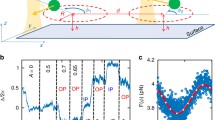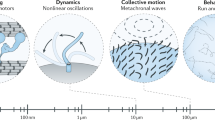Abstract
The coordinated beating of motile cilia is responsible for ovum transport in the oviduct, transport of mucus in the respiratory tract, and is the basis of motility in many single-celled organisms. The beating of a single motile cilium is achieved by the ATP-driven activation cycles of thousands of dynein molecular motors that cause neighboring microtubule doublets within the ciliary axoneme to slide relative to each other. The precise nature of the spatial and temporal coordination of these individual motors is still not completely understood. The emergent geometry and dynamics of ciliary beating is a consequence of the coupling of these internal force-generating motors, the passive elastic properties of the axonemal structure, and the external viscous, incompressible fluid. Here, we extend our integrative model of a single cilium that couples internal force generation with the surrounding fluid to the investigation of multiciliary interaction. This computational model allows us to predict the geometry of beating, along with the detailed description of the time-dependent flow field both near and away from the cilia. We show that synchrony and metachrony can, indeed, arise from hydrodynamic coupling. We also investigate the effects of viscosity and neighboring cilia on ciliary beat frequency. Moreover, since we have precise flow information, we also measure the dependence of the total flow pumped per cilium per beat upon parameters such as viscosity and ciliary spacing.
Similar content being viewed by others
References
Afzelius, B.A., 1976. A human syndrome caused by immotile cilia. Science 193(4250), 317–319.
Afzelius, B.A., 2004. Cilia-related diseases. J. Pathol. 204, 470–477.
Avidor-Reiss, T., Maer, A.M., Koundakjian, E., Polyanovsky, A., Keil, T., Subramaniam, S., Zuker, C.S., 2004. Decoding cilia function: Defining specialized genes required for compartmentalized cilia biogenesis. Cell 117, 527–539.
Brokaw, C., 2001. Simulating the effects of fluid viscosity on the behaviour of sperm flagella. Math. Methods Appl. Sci. 24, 1351.
Brokaw, C., Luck, D., 1983. Bending patterns of chlamydomonas flagella i. Wild-type bending patterns. Cell Motil. 3, 131–150.
Brokaw, C.J., 1972. Flagellar movement: A sliding filament model. Science 178, 455–462.
Camalet, S., Jülicher, F., 2000. Generic aspects of axonemal beating. New J. Phys. 2, 24.1–24.23.
Childress, S., 1981. Mechanics of Swimming and Flying. Cambridge University Press, Cambridge.
Chilvers, M., O’Callaghan, C., 2000. Analysis of ciliary beat pattern and beat frequency using digital high speed imaging: Comparison with the photomultiplier and photodiode methods. Thorax 55, 314–317.
Darnton, N., Turner, L., Breuer, K., Berg, H., 2004. Moving fluid with bacterial carpets. Biophys. J. 86, 1863–1870.
Davenport, J.R., Yoder, B.K., 2005. An incredible decade for the primary cilium: A look at a once-forgotten organelle. Am. J. Physiol. Renal. Physiol. 289, F1159–F1169.
Dillon, R.H., Fauci, L.J., 2000. An integrative model of internal axoneme mechanics and external fluid dynamics in ciliary beating. J. Theor. Biol. 207, 415–430.
Dillon, R.H., Fauci, L.J., Omoto, C., 2003. Mathematical modeling of axoneme mechanics and fluid dynamics in ciliary and sperm motility. Dyn. Contin. Discrete Impuls. Syst. Ser. A Math. Anal. 10(5), 745–757. Progress in Partial Differential Equations (Pullman, WA, 2002).
Dresdner, R., Katz, D., Berger, S., 1980. The propulsion by large amplitude waves of uniflagellar micro-organisms of finite length. J. Fluid Mech. 97, 591.
Eley, L., Yates, L.M., Goodship, J.A., 2005. Cilia and disease. Cur. Opin. Genet. Devel. 15, 308–314.
Fauci, L., McDonald, A., 1994. Sperm motility in the presence of boundaries. Bull. Math. Biol. 57, 679.
Fauci, L.J., Dillon, R.H., 2006. Biofluidmechanics of reproduction. Annu. Rev. Fluid Mech. 38, 371–394.
Fliegauf, M., Omran, H., 2006. Novel tools to unravel molecular mechanisms in cilia-related disorders. Trends Genet. 22(5), 241–245.
Flores, H., Lobaton, E., Mendez-Diez, S., Tlupova, S., Cortez, R., 2005. A study of bacterial flagellar bundling. Bull. Math. Biol. 67, 137–168.
Gheber, L., Korngreen, A., Priel, Z., 1998. Effect of viscosity on metachrony in mucus propelling cilia. Cell Motil. Cytoskel. 39(1), 9–20.
Gheber, L., Priel, Z., 1989. Synchronization between beating cilia. Biophys. J. 55, 183–191.
Gray, J., 1928. Ciliary Movement. Cambridge University Press, Cambridge.
Gray, J., Hancock, G., 1955. The propulsion of sea-urchin spermatoza. J. Exp. Biol. 32, 802–814.
Gueron, S., Levit-Gurevich, K., 1998. Computation of the internal forces in cilia: Application to ciliary motion, the effects of viscosity, and cilia interactions. Biophys. J. 74(4), 1658–1676.
Gueron, S., Levit-Gurevich, K., 1999. Energetic considerations of ciliary beating and the advantage of metachronal coordination. Proc. Natl. Acad. Sci. USA 96(22), 12240–12245.
Gueron, S., Levit-Gurevich, K., 2001. A three-dimensional model for ciliary motion based on the internal 9+2 structure. Proc. Biol. Sci. 268(1467), 599–607.
Gueron, S., Levit-Gurevich, K., Liron, N., Blum, J.J., 1997. Cilia internal mechanism and metachronal coordination as the result of hydrodynamical coupling. Proc. Natl. Acad. Sci. USA 94(12), 6001–6006.
Guirao, B., Joanny, J.-F., 2007. Spontaneous creation of macroscopic flow and metachronal waves in an array of cilia. Biophys. J. 92, 1900–1917.
Higdon, J., 1979a. A hydrodynamic analysis of flagellar propulsion. J. Fluid Mech. 90, 685.
Higdon, J., 1979b. The hydrodynamics analysis of flagellar propulsion: Helical waves. J. Fluid Mech. 94, 331.
Hines, M., Blum, J., 1978. Bend propagation in flagella i. Derivation of equations of motion and their simulation. Biophys. J. 23, 41.
Hines, M., Blum, J., 1979. Bend propagation in flagella ii. Incorporating of dynein cross-bridge kinetics into the equations of motion. Biophys. J. 25, 421.
Ho, H., Suarez, S., 2001. Hyperactivation of mammalian spermatozoa: Function and regulation. Reproduction 122, 519.
Howard, J., 2001. Mechanics of Motor Proteins and the Cytoskeleton. Sinauer Assoc., Sunderland.
Ishijima, S., Hiramoto, Y., 1994. Flexural rigidity of echinoderm sperm flagella. Cell Struct. Funct. 19(6), 349–362.
Kim, M., Bird, J., Van Parys, J., Breuer, K., Powers, T., 2003. A macroscopic scale model of bacterial flagellar bundling. Proc. Natl. Acad. Sci. USA 100(26), 15481–15485.
Lighthill, J.L., 1967. Flagellar hydrodynamics. SIAM Rev. 18, 161–230.
Lim, S., Peskin, C., 2004. Simulations of the whirling instability by the immersed boundary method. SIAM J. Sci. Comput. 25(6), 2066–2083.
Lindemann, C., 2003. Structural-functional relationships of the dynein, spokes, and central-pair projections predicted from an analysis of the foces acting within a flagellum. Biophys. J. 84, 4115–4126.
Lindemann, C., 2007. The geometric clutch as a working hypothesis for future research on cilia and flagella. Ann. N.Y. Acad. Sci. 1101, 477–493.
Machemer, H., 1972. Ciliary activity and the origin of metachrony in paramecium: Effects of increased viscosity. J. Exp. Biol. 57(1), 239–259.
Marshall, W.F., Nonaka, S., 2006. Cilia: Tuning in to the cell’s antenna. Curr. Biol. 16(15), R604–R614.
Mitchell, B., Jacobs, R., Li, J., Chien, S., Kintner, C., 2007. A positive feedback mechanism governs the polarity and motion of motile cilia. Nature 447, 97–101.
Murase, M., 1992. The Dynamics of Cellular Motility. Wiley, Chichester.
Pan, J., Wang, Q., Snell, W.J., 2005. Cilium-generated signaling and cilia-related disorders. Lab. Invest. 85, 452–463.
Peskin, C.S., 1977. Numerical analysis of blood flow in the heart. J. Comput. Phys. 25(3), 220–252.
Peskin, C.S., 2002. The immersed boundary method. Acta Numer. 11, 479–517.
Phan-Thien, N., Tran-Cong, T., Ramia, M., 1987. A boundary element analysis of flagellar propulsion. J. Fluid Mech. 184, 533.
Powers, T., 2001. Role of body rotation in bacterial flagellar bundling. Phys. Rev. E 65, 040903.
Snell, W.J., Pan, J., Wang, Q., 2004. Cilia and flagella revealed: From flagellar assembly in chlamydomonas to human obesity disorders. Cell 117, 693–697.
Solari, C.A., Ganguly, S., Kessler, J.O., Michod, R.E., Goldstein, R.E., 2006. Multicellularity and the functional interdependence of motility and molecular transport. Proc. Natl. Acad. Sci. USA 103, 1353–1358.
Talbot, P., Geiske, C., Knoll, M., 1999. Oocyte pickup by the mammalian oviduct. Mol. Biol. Cell 10(1), 5–8.
Tani, T., Kamimura, S., 1998. Reactivation of sea-urchin sperm flagella induced by rapid photolysis of caged atp. J. Exp. Biol. 201, 1493–1503.
Taylor, G., 1951. Analysis of the swimming of microscopic organisms. Proc. R. Soc. 209, 447.
Vilfan, A., Jülicher, F., 2006. Hydrodynamic flow patterns and synchronization of beating cilia. Phys. Rev. Lett. 96, 058102.
Vogel, G., 2005. Betting on cilia. Science 310(5746), 216–218.
Wiggins, C.H., Goldstein, R.E., 1998. Flexive and propulsive dynamics of elastica at low Reynolds number. Phys. Rev. Lett. 80, 3879–3882.
Wiggins, C.H., Riveline, D., Ott, A., Goldstein, R.E., 1998. Trapping and wiggling: Elastohydrodynamics of driven microfilaments. Biophys. J. 74(2), 1043–1060.
Witman, G., 1990. Introduction to cilia and flagella. In: R. Bloodgood (Ed.), Ciliary and Flagellar Membranes, p. 1. Plenum, New York.
Author information
Authors and Affiliations
Corresponding author
Rights and permissions
About this article
Cite this article
Yang, X., Dillon, R.H. & Fauci, L.J. An Integrative Computational Model of Multiciliary Beating. Bull. Math. Biol. 70, 1192–1215 (2008). https://doi.org/10.1007/s11538-008-9296-3
Received:
Accepted:
Published:
Issue Date:
DOI: https://doi.org/10.1007/s11538-008-9296-3




